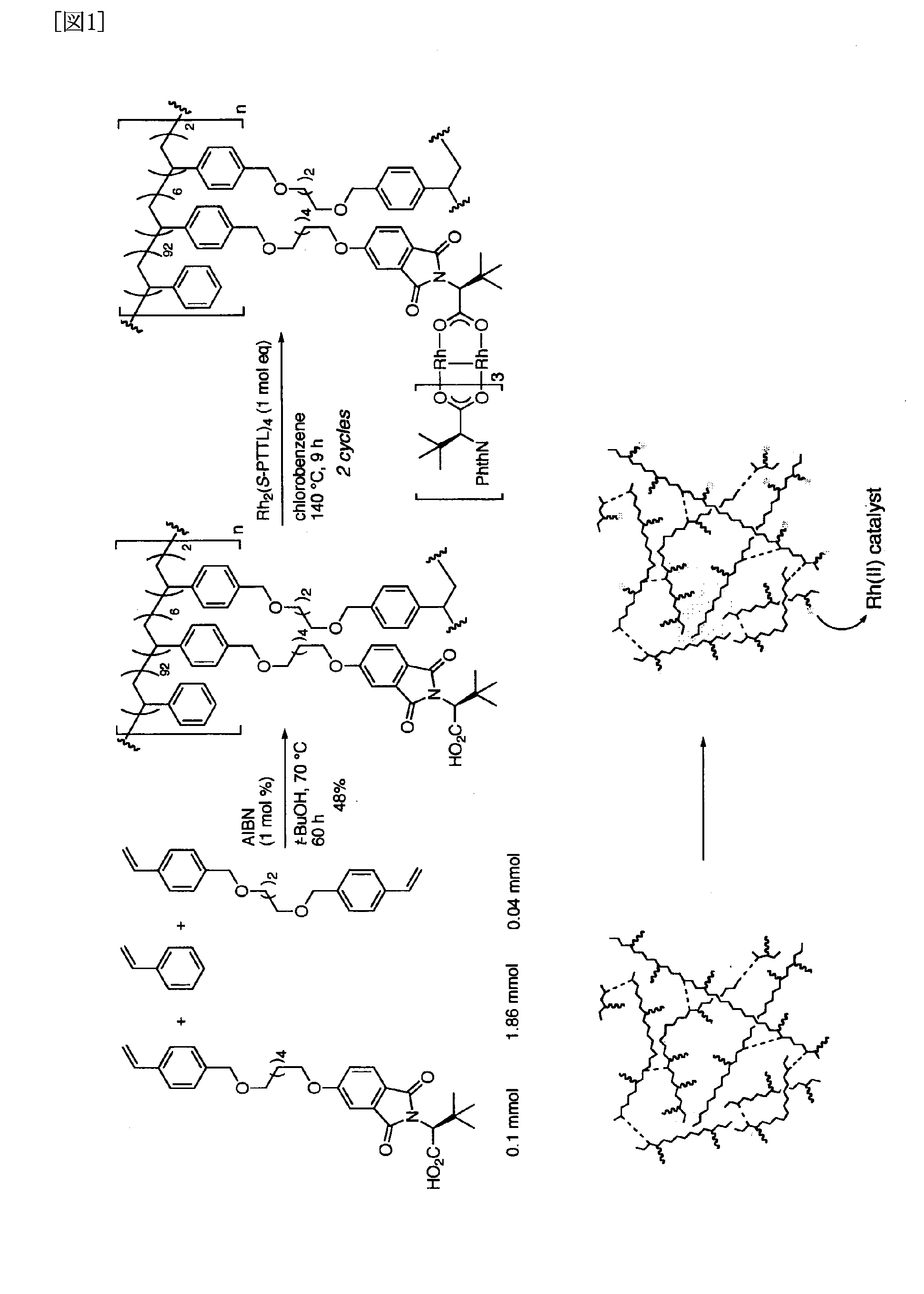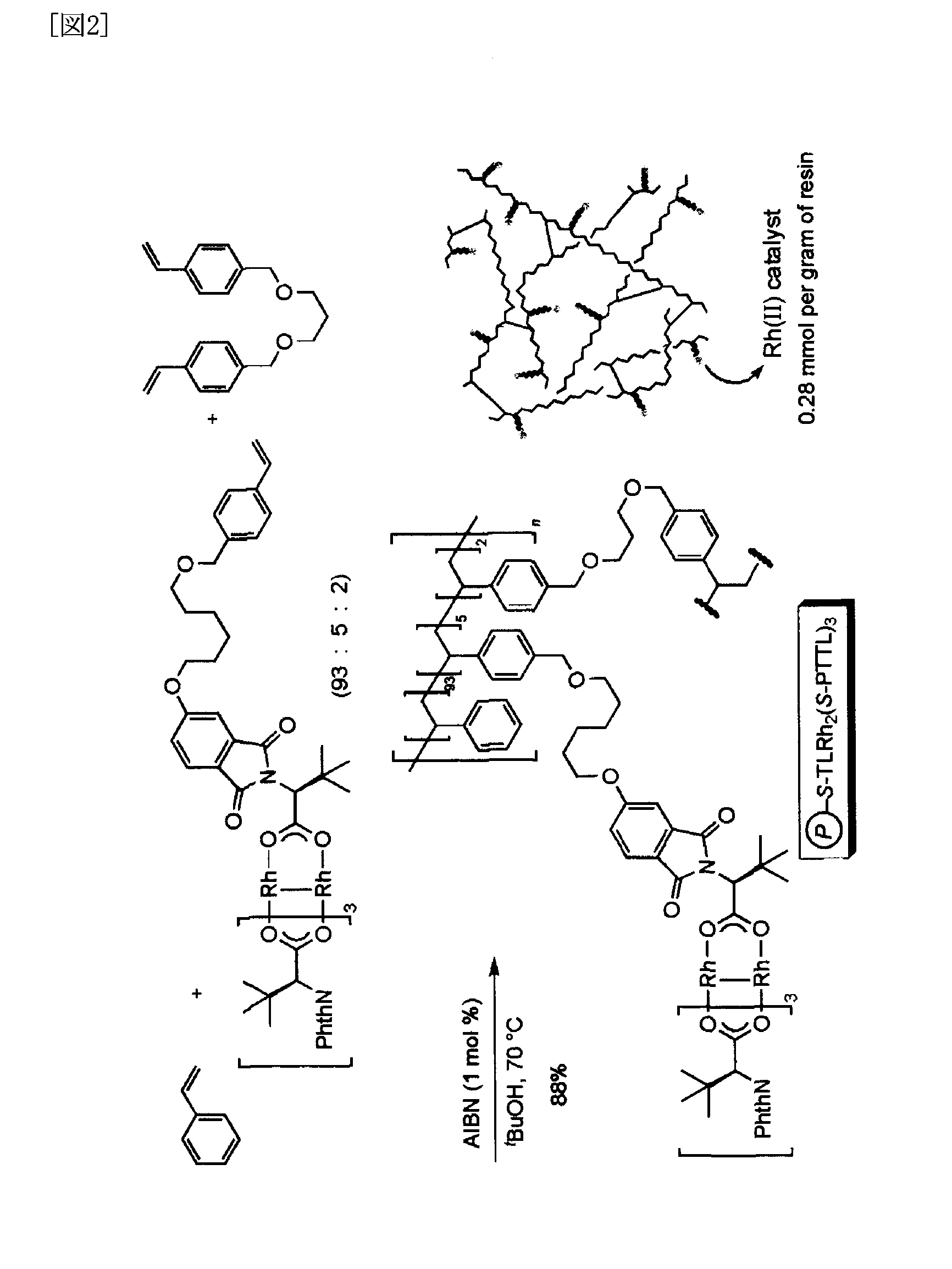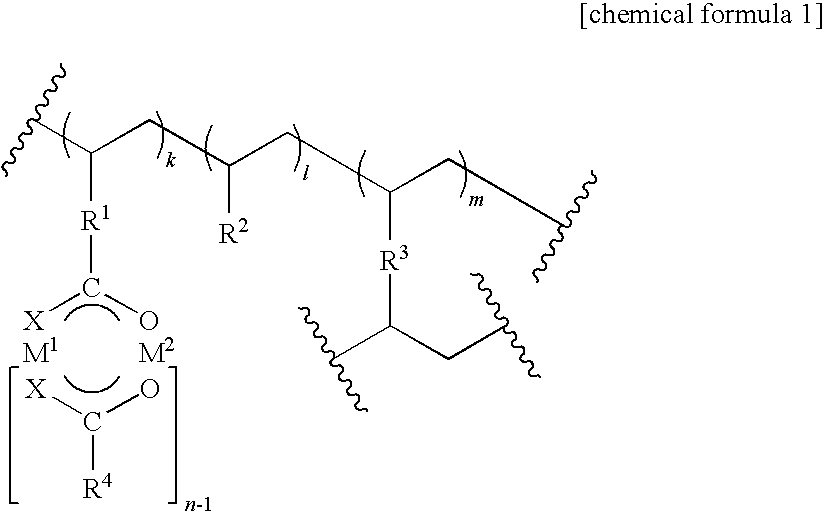Polymer-supported metal complex catalyst
a technology of complex catalysts and polymers, applied in the direction of organic compounds/hydrides/coordination complex catalysts, physical/chemical process catalysts, non-metal conductors, etc., can solve the problems of difficult separation and purification, and economic problems in applying to large-scale synthesis
- Summary
- Abstract
- Description
- Claims
- Application Information
AI Technical Summary
Problems solved by technology
Method used
Image
Examples
example 1
[0076]First, N-4-benzyloxyphthaloyl-(S)-tert-leucine was synthesized from (S)-tert-leucine. The reaction equation is shown below.
[0077]In a pear shaped 50 ml flask equipped with an agitator, 1.27 g of 4-benzyloxyphthalic anhydride (5.0 mmoles) and 721 mg of (S)-tert-leucine (5.5 mmoles) were suspended in 15 ml of toluene. Following the addition of 50 mg of triethylamine (0.5 mmole) and attaching a Dean-Stark device, the mixture was heated and refluxed in an oil bath. The disappearance of the starting material and the intermediate was confirmed (two hours), and the reaction solution was allowed to cool to room temperature. Fifteen milliliters of 5% hydrochloric acid was added, and the reaction solution was extracted using ethyl acetate (2×30 ml). The organic layers were combined and washed using saturated aqueous saline solution, dried using anhydrous sodium sulfate, filtered and concentrated to obtain 1.85 g of the crude product in the form of white solids. The solids were recrystal...
example 2
[0102]A separate preparative method for a metal complex catalyst supported on a polymer is shown below.
[0103]To 30 ml of a THF solution of 1.10 g of N-4-benzyloxyphthaloyl-(S)-tert-leucine (3.0 mmoles) was added 159 mg of 10% Pd / C, and the reaction mixture was agitated for six hours at room temperature in a hydrogen gas atmosphere. The reaction mixture was filtered, and the residue was washed using 10 ml of THF. The combined filtrate and washing was concentrated, and 810 mg of the crude product obtained was recrystallized from 5 ml of 3:1 hexane-ethyl acetate to obtain 665 mg of N-4-hydroyphthaloyl-(S)-tert-leucine (2.40 mmoles, 80%) in the form of colorless flaky crystals. The instrumental analysis data for the N-4-hydroxyphthaloyl-(S)-tert-leucine are shown below.
[0104]TLC Rf 0.41 (9:1 CH2Cl2 / MeOH); 1H NMR (400 MHz, CD3OD) δ1.13 (s, 9H, C(CH3)3), 4.53 (s, 1H, CH(t-Bu)CO2H), 7.11 (dd, J=2.2 Hz, J=8.2 Hz, 1H, Ar), 7.18 (d, J=2.2 Hz, 1H, Ar), 7.69 (d, dd, J=8.2 Hz, 1H, Ar); 13C NMR (...
example 3
[0117]An intramolecular asymmetric C—H insertion reaction was conducted using the polymer supported metal complex catalyst obtained in Example 1. Toluene was added to an insoluble rhodium (II) catalyst, and the swollen catalyst was subsequently cooled to −78° C. A toluene solution of methyl 2-diazo-(6-phenyl) hexanoate, a reaction substrate, was added, and an intramolecular C—H insertion reaction proceeded. The supernatent solution was recovered upon completion of the reaction using decantation and was concentrated to yield a cyclic product. The residue was washed using ethyl acetate and the like and could be used again after drying it under reduced pressure.
[0118]The results are shown in the table below.
TABLE 1en-timeyield [%]cistryRh(II) catalystcycle[h](cis:trans:alkene)ee [%]1aRh2(S-PTTL)4—0.585 (>99:—:—)952 1485 (>99:—:—)943 2482 (>99:—:—)944 5485 (>99:—:—)94510481 (>99:—:—)94615480 (>99:—:—)95720483 (>99:—:—)94aAdv. Synth. Catal. 2005, 347, 1483. 1 mol % of Rh2(S-PTTL)4 was us...
PUM
| Property | Measurement | Unit |
|---|---|---|
| valences | aaaaa | aaaaa |
| chemical | aaaaa | aaaaa |
| optically active | aaaaa | aaaaa |
Abstract
Description
Claims
Application Information
 Login to View More
Login to View More - R&D
- Intellectual Property
- Life Sciences
- Materials
- Tech Scout
- Unparalleled Data Quality
- Higher Quality Content
- 60% Fewer Hallucinations
Browse by: Latest US Patents, China's latest patents, Technical Efficacy Thesaurus, Application Domain, Technology Topic, Popular Technical Reports.
© 2025 PatSnap. All rights reserved.Legal|Privacy policy|Modern Slavery Act Transparency Statement|Sitemap|About US| Contact US: help@patsnap.com



